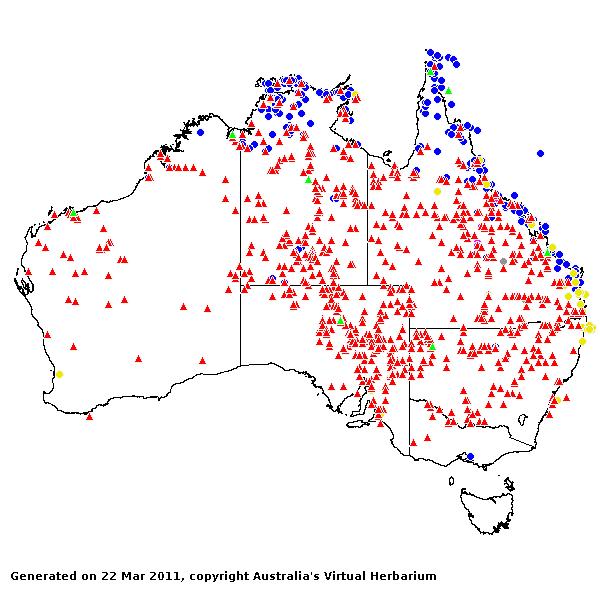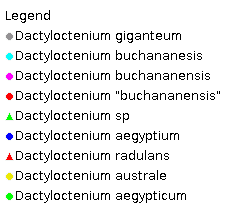Dactyloctenium Enum. Pl. Horti Berol. 1029 (1809).
Derivation:. From Greek daktylos (finger) and ktenos (comb), alluding to the digitate inflorescence in which the spikelets have a comb-like arrangement.
Key references (keys and floras):. G.Bentham, Flora Australiensis 7: 610–614 (1878) as Eleusine in part; C.A.Gardner, Flora of Western Australia 1 Gramineae 210 (1952); M.Lazarides, Flora of Central Australia 462–463 (1981); E.E.Henty, Manual Grasses New Guinea 60 (1969); M.Lazarides, Tropical Grasses S.E. Asia 167–168 (1980); J.C.Tothill and J.B.Hacker, Grasses of Southern Queensland 178–179 (1983); J.P.Jessop, Flora of South Australia 4: 1931–1932 (1986); M.Lazarides, F.Quinn and J.Palmer, Flora of the Kimberley Region 1144–1145 (1992); B.K.Simon, Key to Australian Grasses 90 (1993); S.W.L.Jacobs and S.M.Hastings, Flora of New South Wales 4: 527–528 (1993); N.G. Walsh, Flora of Victoria 2: 570 (1994); D.Sharp and B.K.Simon, AusGrass (2002); K.Mallet (ed.), Flora of Australia 44B: Poaceae 3: 315–320 (2005); J.P.Jessop, Grasses of South Australia 351–353 (2006); S.W.L.Jacobs, R.D.B.Whalley & D.J.B.Wheeler, Grasses of New South Wales, 4th Ed, 194–195 (2008).
W.D.Clayton & S.A.Renvoize, Genera Graminum (1986), genus (373).
Native and naturalised. 13 species, from warm regions. 4 species in Australia, WA, NT, SA, Qld, NSW, and Vic. Also New Guinea and Malesia.
Habit. Annual or perennial, rhizomatous or stoloniferous or tufted or decumbent (mostly low, sometimes sward-forming). Leaf blades narrow. Ligule a fringed membrane (narrow) or a fringe of hairs.
Inflorescence. Inflorescence of spicate main branches (the mature spikelets sometimes almost at right-angles to the rachides), of digitate or subdigitate racemes or spikes, digitate. Spikelet-bearing axes falling entire.
Spikelets. Spikelets laterally compressed, more than 2 flowered, with 2 or more fertile florets, solitary; with naked rachilla extension. Fertile spikelets adaxial (with lower glume against rachis), disarticulating above glumes.
Glumes. Glumes more or less equal, shorter than spikelet, shorter than adjacent lemmas, hairless, the upper awned (or mucronate) or awnless (the lower), keeled, dissimilar (membranous,the lower muticate, the upper obliquely awned or mucronate from just below the tip). Lower glume 1 nerved. Upper glume 1 nerved.
Florets. Fertile florets 3–6. Lemmas acute to shortly awned, often recurved at the tip, not becoming indurated (thinly membranous), entire at apex or incised, muticous or mucronate or awned, 1–3 nerved, glabrous, having flat margins not tucked into palea, strongly 1 keeled. Awns when present 1, apical, non-geniculate, straight or recurving, much shorter than body of lemma. Palea relatively long, apically notched, 2 nerved. Palea keels winged (often) or wingless. Lodicules 2. Stamens 3. Grain small, ellipsoid to subglobose, obtusely triquetrous, sculptured. Hilum short. Pericarp thin (hyaline). Embryo large.
Kranz Anatomy. C4.
2n = 20, 36, and 48, 2, 3, and 4 ploid, commonly adventive.
Habitat. Mesophytic to xerophytic. Sometimes in saline habitats or dunes, mostly in dry sandy soils. Species of open habitats.
Classification. Chloridoideae; Cynodonteae.
Notes. A close-knit but taxonomically difficult genus, undergoing active speciation and introgression in east Africa (Clayton and Renvoize, 1986).
Types Species. D. aegyptium (L.) Willd. as D. aegyptiacum.
Biogeographic Element. Clifford & Simon 1981, Simon & Jacobs 1990: Old World Tropics.


